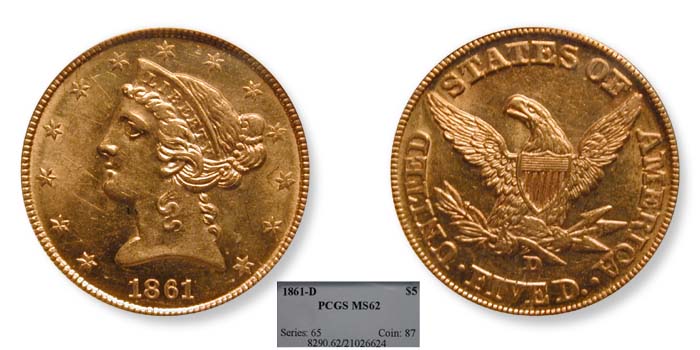1861-D $5 MS62 认证号21026624, PCGS号8290
专家评论
Doug Winter
The 1861-D is the rarest and most numismatically interesting half eagle struck at the Dahlonega Mint.It is known that on December 19, 1860, two obverses dated 1861 were shipped to Dahlonega from Philadelphia. These were received on January 7, 1861 and sometime between that date and April 8, 1861, a total of 1,597 1861-D half eagles were produced. On April 8, 1861, rebel forces seized the Dahlonega Mint. A small number of 1861-D half eagles (probably in the neighborhood of 1,000-2,000 coins) were then made by the Confederacy. There is not way to positively distinguish between the Union and Confederate strikings.
The 1861-D half eagle is a rare coin in any grade, although its overall level of rarity has been overstated. It is usually seen in Very Fine to low end Extremely Fine grades. It is very rare in About Uncirculated and many pieces offered as such are overgraded. In Uncirculated, the 1861-D half eagle is an extremely rare coin.
STRIKE: The 1861-D half eagle has a below average strike. The hair of Liberty is always weak on the curls around the face and at the top of the head. The stars are very weak, especially the third through the eighth. The obverse denticles are mostly visible but they can be weak from 10:00 to 2:00. The reverse has a somewhat sharper strike. The eagle is fairly well defined except for the legs, claws and the arrow feathers. The reverse milling is typically weak from 1:00 to 4:00. Some were struck from slightly misaligned dies and have a slightly off-center appearance. Could these coins possibly be pieces struck by the Confederacy after they seized the mint?
SURFACES: This is among the most difficult Dahlonega half eagles to locate with clean surfaces. The typical example is very heavily abraded with prominent deep marks in the fields. I have seen several which had mint-made roughness in the planchet and a few which had dark streaks as well. In addition, the majority of 1861-D half eagles have been cleaned at one time.
LUSTER: The quality of luster is slightly below average. It can either be frosty or very slightly reflective with a dull, somewhat grainy texture. Coins with good, frosty luster are far more desirable.
COLORATION: The coloration is usually medium to deep orange-gold with some coppery hues visible as well. Most have been cleaned or dipped.
EYE APPEAL: The typical 1861-D half eagle has poor eye appeal. This is due to the fact that this issue is not well struck, has numerous obtrusive marks and shows obvious signs of having been cleaned. A few very attractive examples of this date do exist, including some Mint State coins and a few very choice About Uncirculated pieces. Coins of this quality are very highly prized among Dahlonega collectors.
PERSONAL OBSERVATIONS: To the best of my knowledge, an 1861-D half eagle was the first Dahlonega gold coin to sell for more than $100,000. In 1997, Heritage Rare Coin Galleries and I paid a six-figure price for a superb 1861-D half eagle that was later graded Mint State-63 by PCGS. It was quickly sold to Hancock and Harwell who then placed it in the Duke’s Creek collection. Considering that this is the finest known example of the most desirable Dahlonega half eagle, its record price is well-deserved.
DIE VARIETIES: Only one variety is known.
Variety 39-EE: On the obverse, the date is small and it is placed low in the field. The reverse is the same as described above for 1860-D Variety 38-EE.
David Akers (1975/88)
After the outbreak of the Civil War in 1861, the Dahlonega Mint ceased production but prior to the Mint's closing, 1597 Half Eagles were struck by the U.S. Government and an unknown, but undoubtedly very small, quantity by the Confederacy. The total mintage is probably less than 2500 pieces. As would be expected from the mintage, the 1861-D is very rare in any condition although I have seen more of this issue than I have of the 1842-D Large Date, Large Letters which, in my opinion, is the rarest D Mint Half Eagle. The typical 1861-D is VF. I have seen several that could reasonably be called "uncirculated" and a few others at the AU level. Rounded, "beveled" rims and areas of softness in the strike are common to all examples I have seen.PCGS #
8290
设计师
Christian Gobrecht
边缘
Reeded
直径
21.65 毫米
重量
8.36 克
铸币数量
1597
金属成分
90% Gold, 10% Copper
更高评级数量
4
评级较低的钱币数量
79
地区
The United States of America
价格指南
PCGS 数量报告
拍卖 - PCGS 评级的
拍卖 - NGC 评级的
稀有性和存量估计 了解更多
| 所有评级 | 75 |
| 60或以上 | 9 |
| 65或以上 | 0 |
| 所有评级 | R-8.2 |
| 60或以上 | R-9.6 |
| 65或以上 | R-10.1 |
| 所有评级 | 25 / 112 TIE |
| 60或以上 | 44 / 112 TIE |
| 65或以上 | 1 / 112 |
| 所有评级 | 34 / 218 TIE |
| 60或以上 | 71 / 218 TIE |
| 65或以上 | 1 / 218 |





















